Principles of Marketing: Chapter 9- Developing New Products
VerifiedAdded on 2022/06/07
|13
|4109
|14
Assignment
AI Summary
Contribute Materials
Your contribution can guide someone’s learning journey. Share your
documents today.
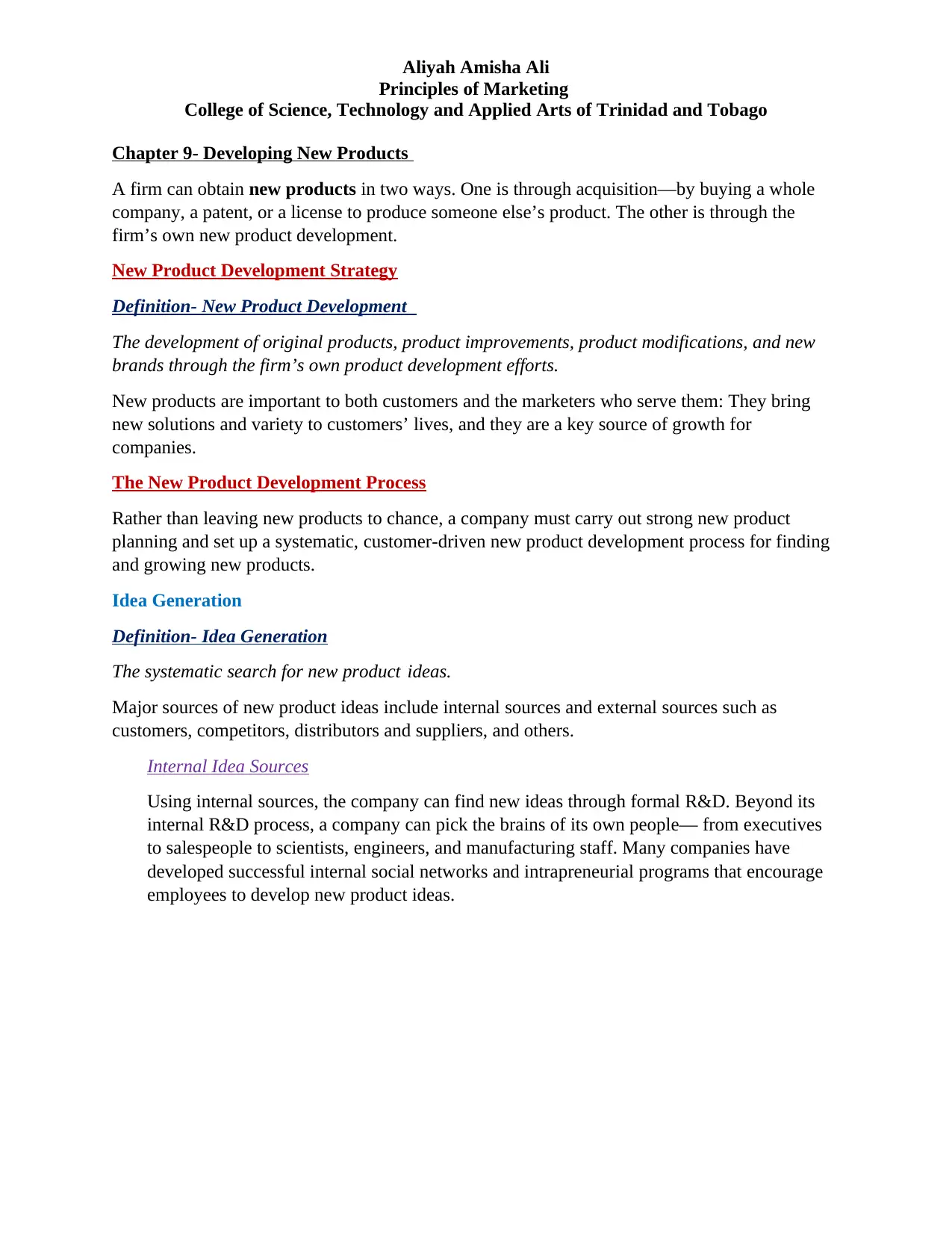
Aliyah Amisha Ali
Principles of Marketing
College of Science, Technology and Applied Arts of Trinidad and Tobago
Chapter 9- Developing New Products
A firm can obtain new products in two ways. One is through acquisition—by buying a whole
company, a patent, or a license to produce someone else’s product. The other is through the
firm’s own new product development.
New Product Development Strategy
Definition- New Product Development
The development of original products, product improvements, product modifications, and new
brands through the firm’s own product development efforts.
New products are important to both customers and the marketers who serve them: They bring
new solutions and variety to customers’ lives, and they are a key source of growth for
companies.
The New Product Development Process
Rather than leaving new products to chance, a company must carry out strong new product
planning and set up a systematic, customer-driven new product development process for finding
and growing new products.
Idea Generation
Definition- Idea Generation
The systematic search for new product ideas.
Major sources of new product ideas include internal sources and external sources such as
customers, competitors, distributors and suppliers, and others.
Internal Idea Sources
Using internal sources, the company can find new ideas through formal R&D. Beyond its
internal R&D process, a company can pick the brains of its own people— from executives
to salespeople to scientists, engineers, and manufacturing staff. Many companies have
developed successful internal social networks and intrapreneurial programs that encourage
employees to develop new product ideas.
Principles of Marketing
College of Science, Technology and Applied Arts of Trinidad and Tobago
Chapter 9- Developing New Products
A firm can obtain new products in two ways. One is through acquisition—by buying a whole
company, a patent, or a license to produce someone else’s product. The other is through the
firm’s own new product development.
New Product Development Strategy
Definition- New Product Development
The development of original products, product improvements, product modifications, and new
brands through the firm’s own product development efforts.
New products are important to both customers and the marketers who serve them: They bring
new solutions and variety to customers’ lives, and they are a key source of growth for
companies.
The New Product Development Process
Rather than leaving new products to chance, a company must carry out strong new product
planning and set up a systematic, customer-driven new product development process for finding
and growing new products.
Idea Generation
Definition- Idea Generation
The systematic search for new product ideas.
Major sources of new product ideas include internal sources and external sources such as
customers, competitors, distributors and suppliers, and others.
Internal Idea Sources
Using internal sources, the company can find new ideas through formal R&D. Beyond its
internal R&D process, a company can pick the brains of its own people— from executives
to salespeople to scientists, engineers, and manufacturing staff. Many companies have
developed successful internal social networks and intrapreneurial programs that encourage
employees to develop new product ideas.
Secure Best Marks with AI Grader
Need help grading? Try our AI Grader for instant feedback on your assignments.
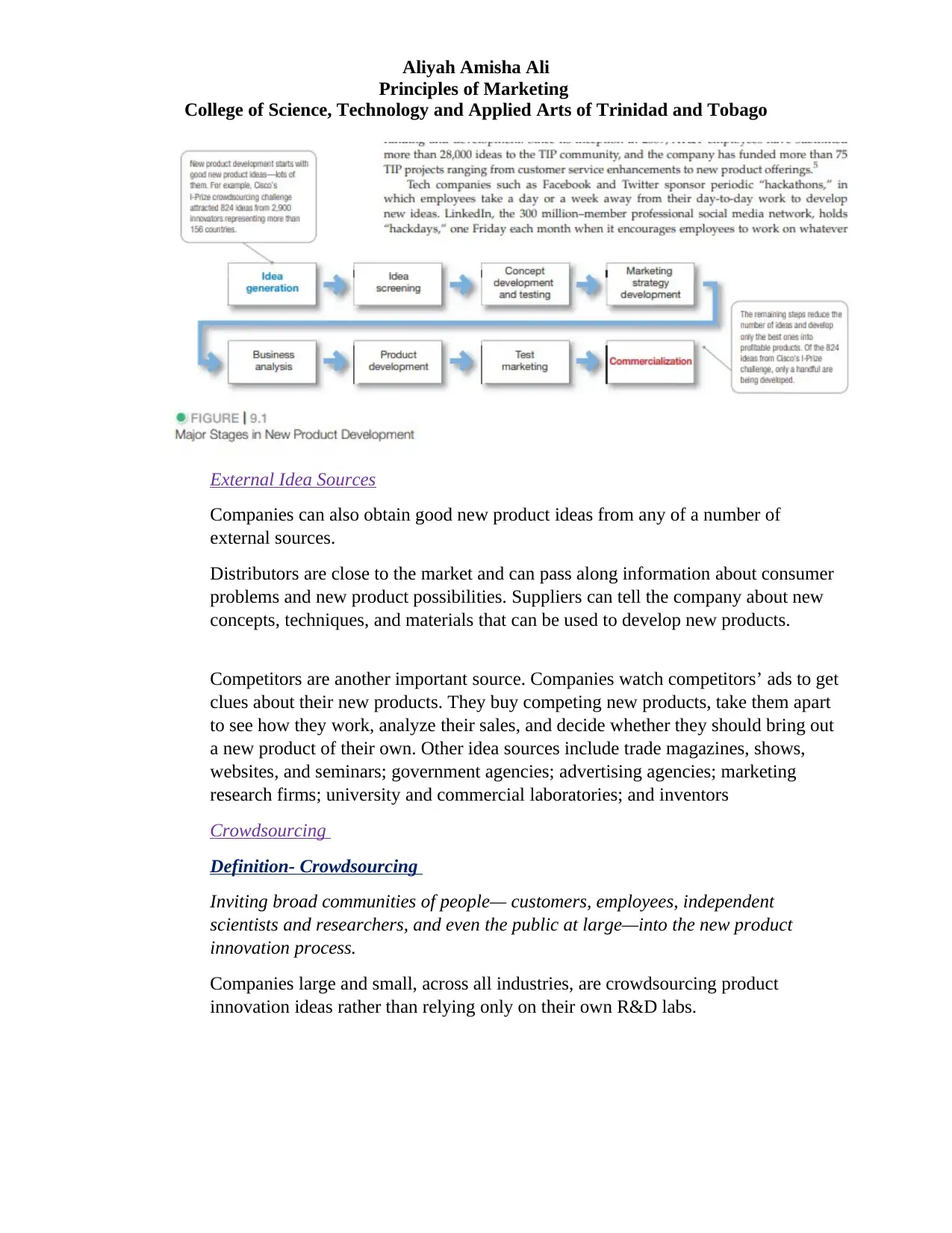
Aliyah Amisha Ali
Principles of Marketing
College of Science, Technology and Applied Arts of Trinidad and Tobago
External Idea Sources
Companies can also obtain good new product ideas from any of a number of
external sources.
Distributors are close to the market and can pass along information about consumer
problems and new product possibilities. Suppliers can tell the company about new
concepts, techniques, and materials that can be used to develop new products.
Competitors are another important source. Companies watch competitors’ ads to get
clues about their new products. They buy competing new products, take them apart
to see how they work, analyze their sales, and decide whether they should bring out
a new product of their own. Other idea sources include trade magazines, shows,
websites, and seminars; government agencies; advertising agencies; marketing
research firms; university and commercial laboratories; and inventors
Crowdsourcing
Definition- Crowdsourcing
Inviting broad communities of people— customers, employees, independent
scientists and researchers, and even the public at large—into the new product
innovation process.
Companies large and small, across all industries, are crowdsourcing product
innovation ideas rather than relying only on their own R&D labs.
Principles of Marketing
College of Science, Technology and Applied Arts of Trinidad and Tobago
External Idea Sources
Companies can also obtain good new product ideas from any of a number of
external sources.
Distributors are close to the market and can pass along information about consumer
problems and new product possibilities. Suppliers can tell the company about new
concepts, techniques, and materials that can be used to develop new products.
Competitors are another important source. Companies watch competitors’ ads to get
clues about their new products. They buy competing new products, take them apart
to see how they work, analyze their sales, and decide whether they should bring out
a new product of their own. Other idea sources include trade magazines, shows,
websites, and seminars; government agencies; advertising agencies; marketing
research firms; university and commercial laboratories; and inventors
Crowdsourcing
Definition- Crowdsourcing
Inviting broad communities of people— customers, employees, independent
scientists and researchers, and even the public at large—into the new product
innovation process.
Companies large and small, across all industries, are crowdsourcing product
innovation ideas rather than relying only on their own R&D labs.
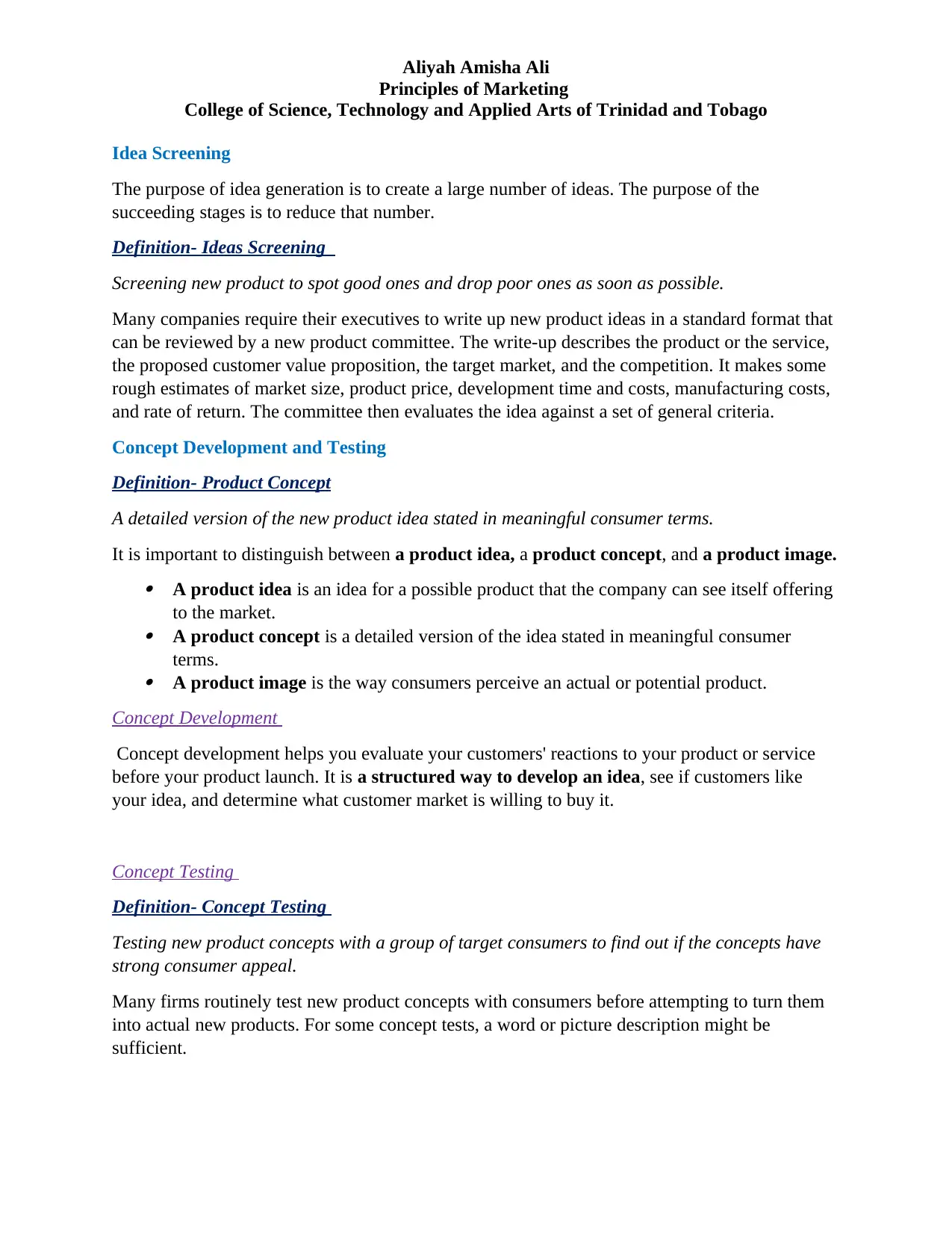
Aliyah Amisha Ali
Principles of Marketing
College of Science, Technology and Applied Arts of Trinidad and Tobago
Idea Screening
The purpose of idea generation is to create a large number of ideas. The purpose of the
succeeding stages is to reduce that number.
Definition- Ideas Screening
Screening new product to spot good ones and drop poor ones as soon as possible.
Many companies require their executives to write up new product ideas in a standard format that
can be reviewed by a new product committee. The write-up describes the product or the service,
the proposed customer value proposition, the target market, and the competition. It makes some
rough estimates of market size, product price, development time and costs, manufacturing costs,
and rate of return. The committee then evaluates the idea against a set of general criteria.
Concept Development and Testing
Definition- Product Concept
A detailed version of the new product idea stated in meaningful consumer terms.
It is important to distinguish between a product idea, a product concept, and a product image. A product idea is an idea for a possible product that the company can see itself offering
to the market.
A product concept is a detailed version of the idea stated in meaningful consumer
terms.
A product image is the way consumers perceive an actual or potential product.
Concept Development
Concept development helps you evaluate your customers' reactions to your product or service
before your product launch. It is a structured way to develop an idea, see if customers like
your idea, and determine what customer market is willing to buy it.
Concept Testing
Definition- Concept Testing
Testing new product concepts with a group of target consumers to find out if the concepts have
strong consumer appeal.
Many firms routinely test new product concepts with consumers before attempting to turn them
into actual new products. For some concept tests, a word or picture description might be
sufficient.
Principles of Marketing
College of Science, Technology and Applied Arts of Trinidad and Tobago
Idea Screening
The purpose of idea generation is to create a large number of ideas. The purpose of the
succeeding stages is to reduce that number.
Definition- Ideas Screening
Screening new product to spot good ones and drop poor ones as soon as possible.
Many companies require their executives to write up new product ideas in a standard format that
can be reviewed by a new product committee. The write-up describes the product or the service,
the proposed customer value proposition, the target market, and the competition. It makes some
rough estimates of market size, product price, development time and costs, manufacturing costs,
and rate of return. The committee then evaluates the idea against a set of general criteria.
Concept Development and Testing
Definition- Product Concept
A detailed version of the new product idea stated in meaningful consumer terms.
It is important to distinguish between a product idea, a product concept, and a product image. A product idea is an idea for a possible product that the company can see itself offering
to the market.
A product concept is a detailed version of the idea stated in meaningful consumer
terms.
A product image is the way consumers perceive an actual or potential product.
Concept Development
Concept development helps you evaluate your customers' reactions to your product or service
before your product launch. It is a structured way to develop an idea, see if customers like
your idea, and determine what customer market is willing to buy it.
Concept Testing
Definition- Concept Testing
Testing new product concepts with a group of target consumers to find out if the concepts have
strong consumer appeal.
Many firms routinely test new product concepts with consumers before attempting to turn them
into actual new products. For some concept tests, a word or picture description might be
sufficient.
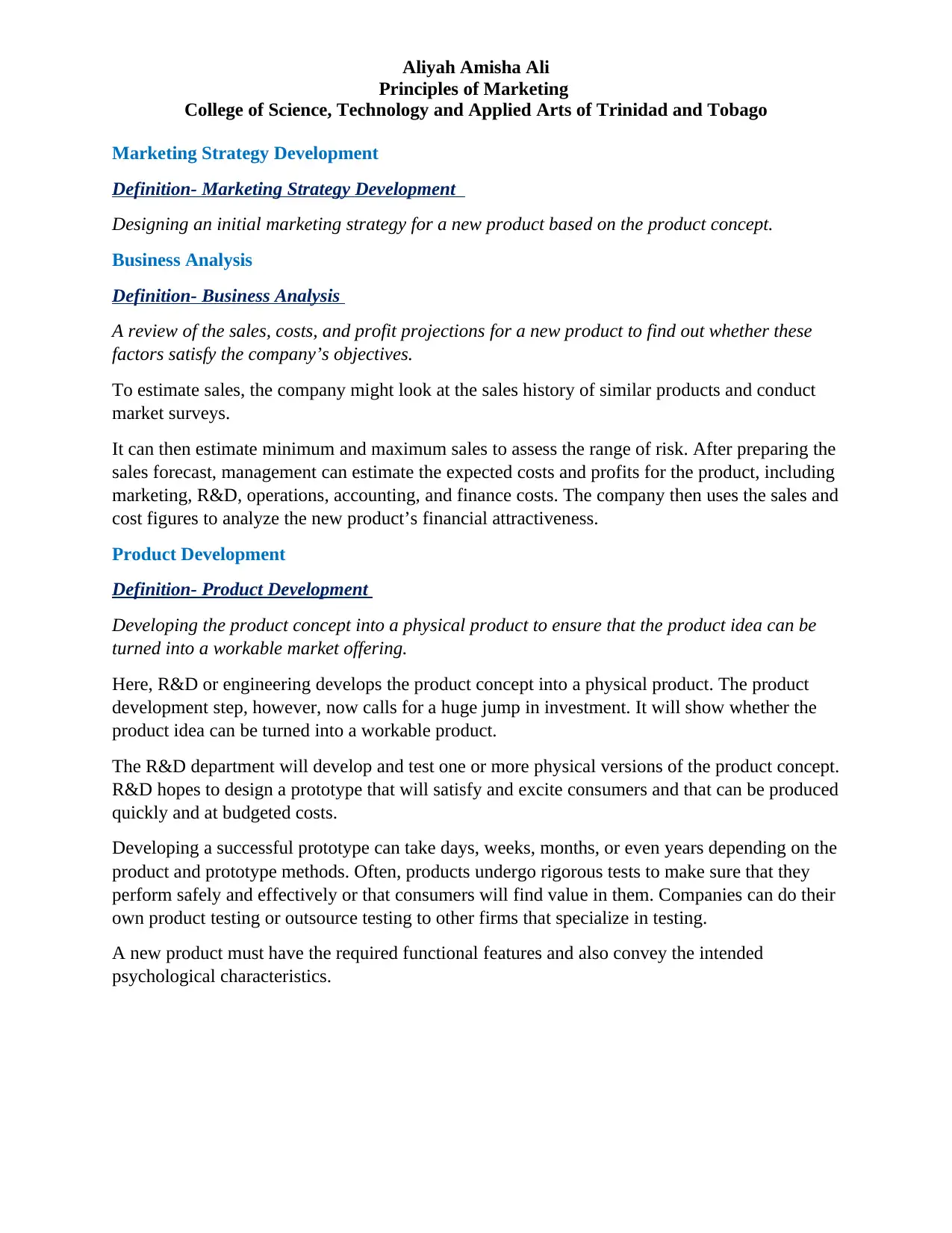
Aliyah Amisha Ali
Principles of Marketing
College of Science, Technology and Applied Arts of Trinidad and Tobago
Marketing Strategy Development
Definition- Marketing Strategy Development
Designing an initial marketing strategy for a new product based on the product concept.
Business Analysis
Definition- Business Analysis
A review of the sales, costs, and profit projections for a new product to find out whether these
factors satisfy the company’s objectives.
To estimate sales, the company might look at the sales history of similar products and conduct
market surveys.
It can then estimate minimum and maximum sales to assess the range of risk. After preparing the
sales forecast, management can estimate the expected costs and profits for the product, including
marketing, R&D, operations, accounting, and finance costs. The company then uses the sales and
cost figures to analyze the new product’s financial attractiveness.
Product Development
Definition- Product Development
Developing the product concept into a physical product to ensure that the product idea can be
turned into a workable market offering.
Here, R&D or engineering develops the product concept into a physical product. The product
development step, however, now calls for a huge jump in investment. It will show whether the
product idea can be turned into a workable product.
The R&D department will develop and test one or more physical versions of the product concept.
R&D hopes to design a prototype that will satisfy and excite consumers and that can be produced
quickly and at budgeted costs.
Developing a successful prototype can take days, weeks, months, or even years depending on the
product and prototype methods. Often, products undergo rigorous tests to make sure that they
perform safely and effectively or that consumers will find value in them. Companies can do their
own product testing or outsource testing to other firms that specialize in testing.
A new product must have the required functional features and also convey the intended
psychological characteristics.
Principles of Marketing
College of Science, Technology and Applied Arts of Trinidad and Tobago
Marketing Strategy Development
Definition- Marketing Strategy Development
Designing an initial marketing strategy for a new product based on the product concept.
Business Analysis
Definition- Business Analysis
A review of the sales, costs, and profit projections for a new product to find out whether these
factors satisfy the company’s objectives.
To estimate sales, the company might look at the sales history of similar products and conduct
market surveys.
It can then estimate minimum and maximum sales to assess the range of risk. After preparing the
sales forecast, management can estimate the expected costs and profits for the product, including
marketing, R&D, operations, accounting, and finance costs. The company then uses the sales and
cost figures to analyze the new product’s financial attractiveness.
Product Development
Definition- Product Development
Developing the product concept into a physical product to ensure that the product idea can be
turned into a workable market offering.
Here, R&D or engineering develops the product concept into a physical product. The product
development step, however, now calls for a huge jump in investment. It will show whether the
product idea can be turned into a workable product.
The R&D department will develop and test one or more physical versions of the product concept.
R&D hopes to design a prototype that will satisfy and excite consumers and that can be produced
quickly and at budgeted costs.
Developing a successful prototype can take days, weeks, months, or even years depending on the
product and prototype methods. Often, products undergo rigorous tests to make sure that they
perform safely and effectively or that consumers will find value in them. Companies can do their
own product testing or outsource testing to other firms that specialize in testing.
A new product must have the required functional features and also convey the intended
psychological characteristics.
Secure Best Marks with AI Grader
Need help grading? Try our AI Grader for instant feedback on your assignments.
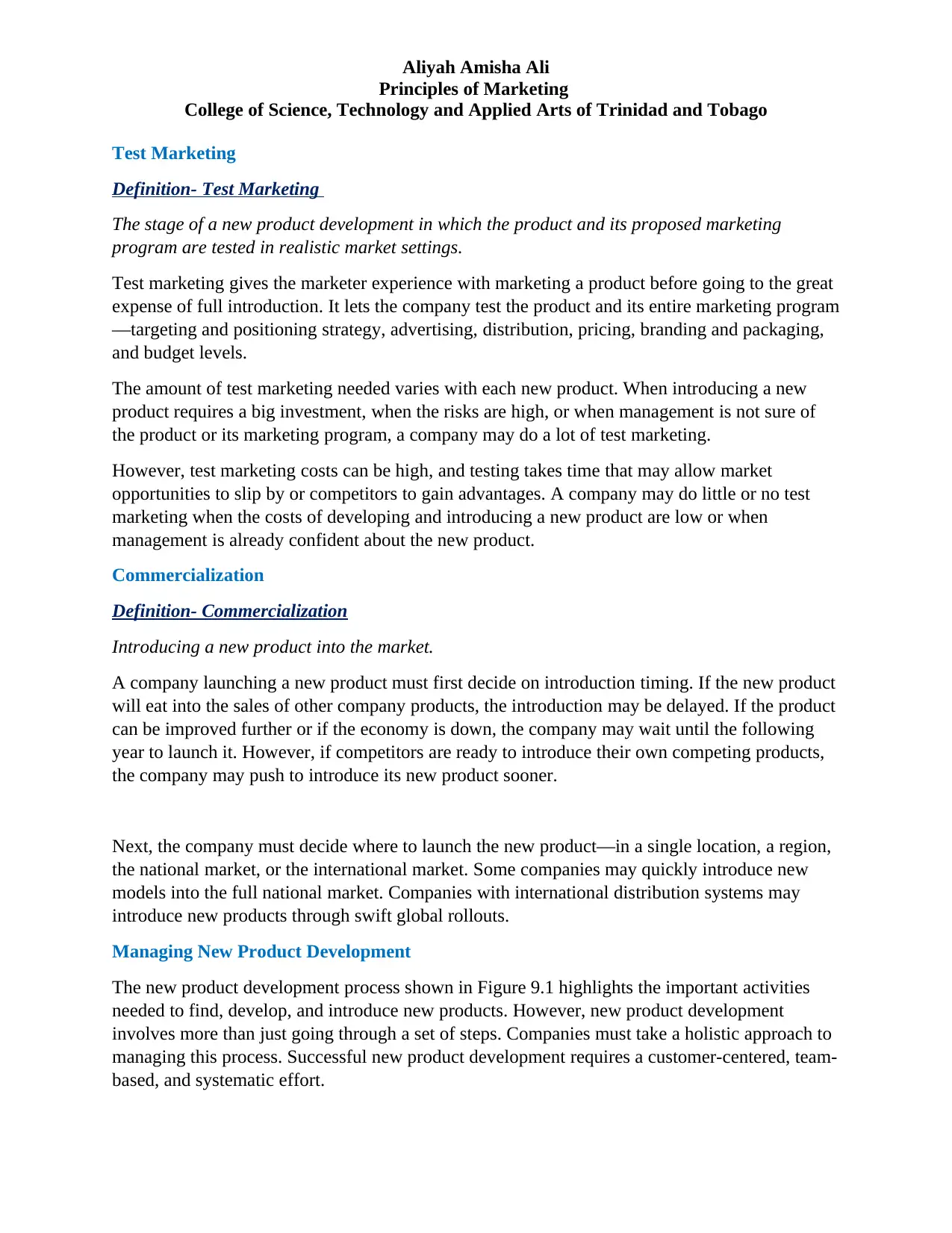
Aliyah Amisha Ali
Principles of Marketing
College of Science, Technology and Applied Arts of Trinidad and Tobago
Test Marketing
Definition- Test Marketing
The stage of a new product development in which the product and its proposed marketing
program are tested in realistic market settings.
Test marketing gives the marketer experience with marketing a product before going to the great
expense of full introduction. It lets the company test the product and its entire marketing program
—targeting and positioning strategy, advertising, distribution, pricing, branding and packaging,
and budget levels.
The amount of test marketing needed varies with each new product. When introducing a new
product requires a big investment, when the risks are high, or when management is not sure of
the product or its marketing program, a company may do a lot of test marketing.
However, test marketing costs can be high, and testing takes time that may allow market
opportunities to slip by or competitors to gain advantages. A company may do little or no test
marketing when the costs of developing and introducing a new product are low or when
management is already confident about the new product.
Commercialization
Definition- Commercialization
Introducing a new product into the market.
A company launching a new product must first decide on introduction timing. If the new product
will eat into the sales of other company products, the introduction may be delayed. If the product
can be improved further or if the economy is down, the company may wait until the following
year to launch it. However, if competitors are ready to introduce their own competing products,
the company may push to introduce its new product sooner.
Next, the company must decide where to launch the new product—in a single location, a region,
the national market, or the international market. Some companies may quickly introduce new
models into the full national market. Companies with international distribution systems may
introduce new products through swift global rollouts.
Managing New Product Development
The new product development process shown in Figure 9.1 highlights the important activities
needed to find, develop, and introduce new products. However, new product development
involves more than just going through a set of steps. Companies must take a holistic approach to
managing this process. Successful new product development requires a customer-centered, team-
based, and systematic effort.
Principles of Marketing
College of Science, Technology and Applied Arts of Trinidad and Tobago
Test Marketing
Definition- Test Marketing
The stage of a new product development in which the product and its proposed marketing
program are tested in realistic market settings.
Test marketing gives the marketer experience with marketing a product before going to the great
expense of full introduction. It lets the company test the product and its entire marketing program
—targeting and positioning strategy, advertising, distribution, pricing, branding and packaging,
and budget levels.
The amount of test marketing needed varies with each new product. When introducing a new
product requires a big investment, when the risks are high, or when management is not sure of
the product or its marketing program, a company may do a lot of test marketing.
However, test marketing costs can be high, and testing takes time that may allow market
opportunities to slip by or competitors to gain advantages. A company may do little or no test
marketing when the costs of developing and introducing a new product are low or when
management is already confident about the new product.
Commercialization
Definition- Commercialization
Introducing a new product into the market.
A company launching a new product must first decide on introduction timing. If the new product
will eat into the sales of other company products, the introduction may be delayed. If the product
can be improved further or if the economy is down, the company may wait until the following
year to launch it. However, if competitors are ready to introduce their own competing products,
the company may push to introduce its new product sooner.
Next, the company must decide where to launch the new product—in a single location, a region,
the national market, or the international market. Some companies may quickly introduce new
models into the full national market. Companies with international distribution systems may
introduce new products through swift global rollouts.
Managing New Product Development
The new product development process shown in Figure 9.1 highlights the important activities
needed to find, develop, and introduce new products. However, new product development
involves more than just going through a set of steps. Companies must take a holistic approach to
managing this process. Successful new product development requires a customer-centered, team-
based, and systematic effort.
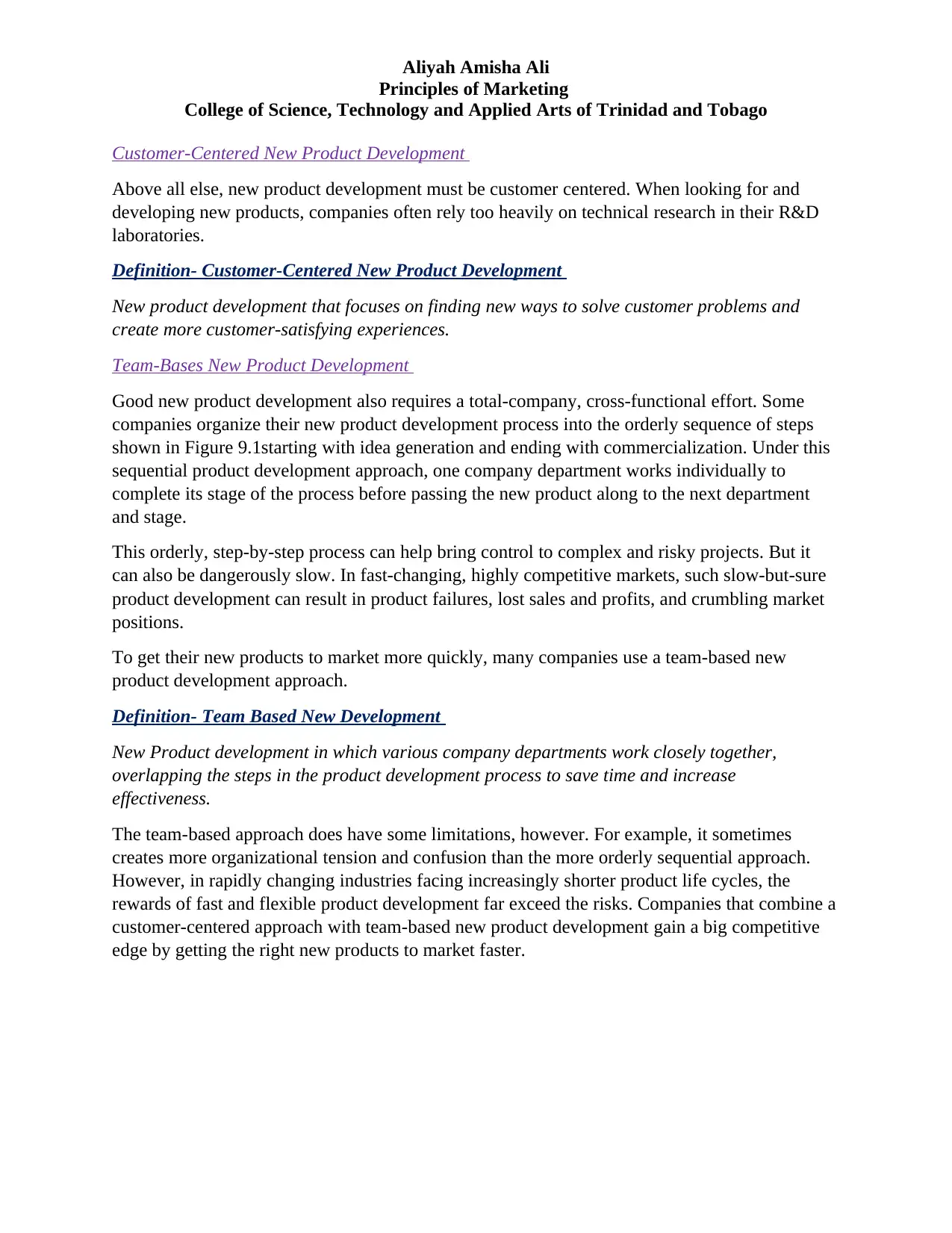
Aliyah Amisha Ali
Principles of Marketing
College of Science, Technology and Applied Arts of Trinidad and Tobago
Customer-Centered New Product Development
Above all else, new product development must be customer centered. When looking for and
developing new products, companies often rely too heavily on technical research in their R&D
laboratories.
Definition- Customer-Centered New Product Development
New product development that focuses on finding new ways to solve customer problems and
create more customer-satisfying experiences.
Team-Bases New Product Development
Good new product development also requires a total-company, cross-functional effort. Some
companies organize their new product development process into the orderly sequence of steps
shown in Figure 9.1starting with idea generation and ending with commercialization. Under this
sequential product development approach, one company department works individually to
complete its stage of the process before passing the new product along to the next department
and stage.
This orderly, step-by-step process can help bring control to complex and risky projects. But it
can also be dangerously slow. In fast-changing, highly competitive markets, such slow-but-sure
product development can result in product failures, lost sales and profits, and crumbling market
positions.
To get their new products to market more quickly, many companies use a team-based new
product development approach.
Definition- Team Based New Development
New Product development in which various company departments work closely together,
overlapping the steps in the product development process to save time and increase
effectiveness.
The team-based approach does have some limitations, however. For example, it sometimes
creates more organizational tension and confusion than the more orderly sequential approach.
However, in rapidly changing industries facing increasingly shorter product life cycles, the
rewards of fast and flexible product development far exceed the risks. Companies that combine a
customer-centered approach with team-based new product development gain a big competitive
edge by getting the right new products to market faster.
Principles of Marketing
College of Science, Technology and Applied Arts of Trinidad and Tobago
Customer-Centered New Product Development
Above all else, new product development must be customer centered. When looking for and
developing new products, companies often rely too heavily on technical research in their R&D
laboratories.
Definition- Customer-Centered New Product Development
New product development that focuses on finding new ways to solve customer problems and
create more customer-satisfying experiences.
Team-Bases New Product Development
Good new product development also requires a total-company, cross-functional effort. Some
companies organize their new product development process into the orderly sequence of steps
shown in Figure 9.1starting with idea generation and ending with commercialization. Under this
sequential product development approach, one company department works individually to
complete its stage of the process before passing the new product along to the next department
and stage.
This orderly, step-by-step process can help bring control to complex and risky projects. But it
can also be dangerously slow. In fast-changing, highly competitive markets, such slow-but-sure
product development can result in product failures, lost sales and profits, and crumbling market
positions.
To get their new products to market more quickly, many companies use a team-based new
product development approach.
Definition- Team Based New Development
New Product development in which various company departments work closely together,
overlapping the steps in the product development process to save time and increase
effectiveness.
The team-based approach does have some limitations, however. For example, it sometimes
creates more organizational tension and confusion than the more orderly sequential approach.
However, in rapidly changing industries facing increasingly shorter product life cycles, the
rewards of fast and flexible product development far exceed the risks. Companies that combine a
customer-centered approach with team-based new product development gain a big competitive
edge by getting the right new products to market faster.
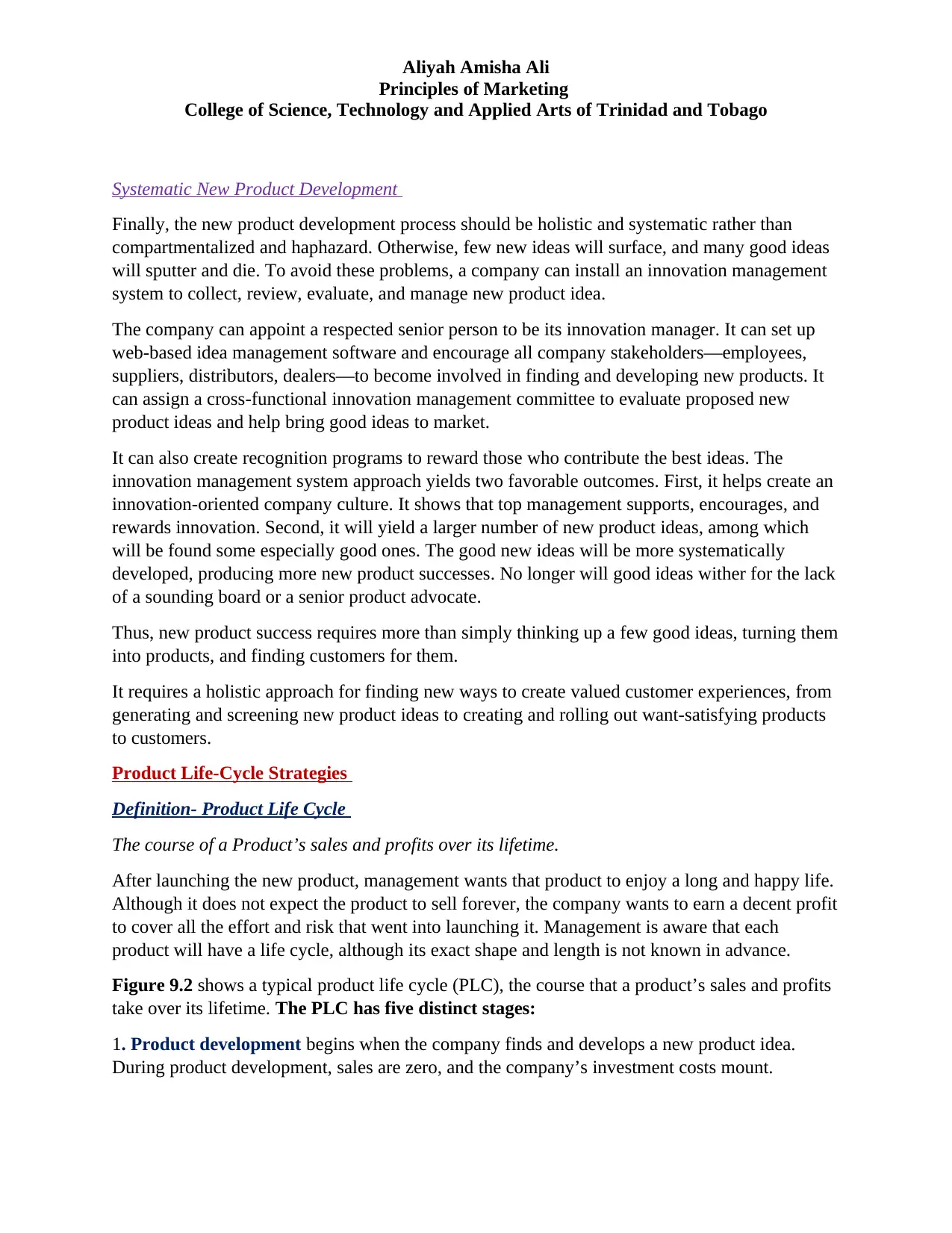
Aliyah Amisha Ali
Principles of Marketing
College of Science, Technology and Applied Arts of Trinidad and Tobago
Systematic New Product Development
Finally, the new product development process should be holistic and systematic rather than
compartmentalized and haphazard. Otherwise, few new ideas will surface, and many good ideas
will sputter and die. To avoid these problems, a company can install an innovation management
system to collect, review, evaluate, and manage new product idea.
The company can appoint a respected senior person to be its innovation manager. It can set up
web-based idea management software and encourage all company stakeholders—employees,
suppliers, distributors, dealers—to become involved in finding and developing new products. It
can assign a cross-functional innovation management committee to evaluate proposed new
product ideas and help bring good ideas to market.
It can also create recognition programs to reward those who contribute the best ideas. The
innovation management system approach yields two favorable outcomes. First, it helps create an
innovation-oriented company culture. It shows that top management supports, encourages, and
rewards innovation. Second, it will yield a larger number of new product ideas, among which
will be found some especially good ones. The good new ideas will be more systematically
developed, producing more new product successes. No longer will good ideas wither for the lack
of a sounding board or a senior product advocate.
Thus, new product success requires more than simply thinking up a few good ideas, turning them
into products, and finding customers for them.
It requires a holistic approach for finding new ways to create valued customer experiences, from
generating and screening new product ideas to creating and rolling out want-satisfying products
to customers.
Product Life-Cycle Strategies
Definition- Product Life Cycle
The course of a Product’s sales and profits over its lifetime.
After launching the new product, management wants that product to enjoy a long and happy life.
Although it does not expect the product to sell forever, the company wants to earn a decent profit
to cover all the effort and risk that went into launching it. Management is aware that each
product will have a life cycle, although its exact shape and length is not known in advance.
Figure 9.2 shows a typical product life cycle (PLC), the course that a product’s sales and profits
take over its lifetime. The PLC has five distinct stages:
1. Product development begins when the company finds and develops a new product idea.
During product development, sales are zero, and the company’s investment costs mount.
Principles of Marketing
College of Science, Technology and Applied Arts of Trinidad and Tobago
Systematic New Product Development
Finally, the new product development process should be holistic and systematic rather than
compartmentalized and haphazard. Otherwise, few new ideas will surface, and many good ideas
will sputter and die. To avoid these problems, a company can install an innovation management
system to collect, review, evaluate, and manage new product idea.
The company can appoint a respected senior person to be its innovation manager. It can set up
web-based idea management software and encourage all company stakeholders—employees,
suppliers, distributors, dealers—to become involved in finding and developing new products. It
can assign a cross-functional innovation management committee to evaluate proposed new
product ideas and help bring good ideas to market.
It can also create recognition programs to reward those who contribute the best ideas. The
innovation management system approach yields two favorable outcomes. First, it helps create an
innovation-oriented company culture. It shows that top management supports, encourages, and
rewards innovation. Second, it will yield a larger number of new product ideas, among which
will be found some especially good ones. The good new ideas will be more systematically
developed, producing more new product successes. No longer will good ideas wither for the lack
of a sounding board or a senior product advocate.
Thus, new product success requires more than simply thinking up a few good ideas, turning them
into products, and finding customers for them.
It requires a holistic approach for finding new ways to create valued customer experiences, from
generating and screening new product ideas to creating and rolling out want-satisfying products
to customers.
Product Life-Cycle Strategies
Definition- Product Life Cycle
The course of a Product’s sales and profits over its lifetime.
After launching the new product, management wants that product to enjoy a long and happy life.
Although it does not expect the product to sell forever, the company wants to earn a decent profit
to cover all the effort and risk that went into launching it. Management is aware that each
product will have a life cycle, although its exact shape and length is not known in advance.
Figure 9.2 shows a typical product life cycle (PLC), the course that a product’s sales and profits
take over its lifetime. The PLC has five distinct stages:
1. Product development begins when the company finds and develops a new product idea.
During product development, sales are zero, and the company’s investment costs mount.
Paraphrase This Document
Need a fresh take? Get an instant paraphrase of this document with our AI Paraphraser
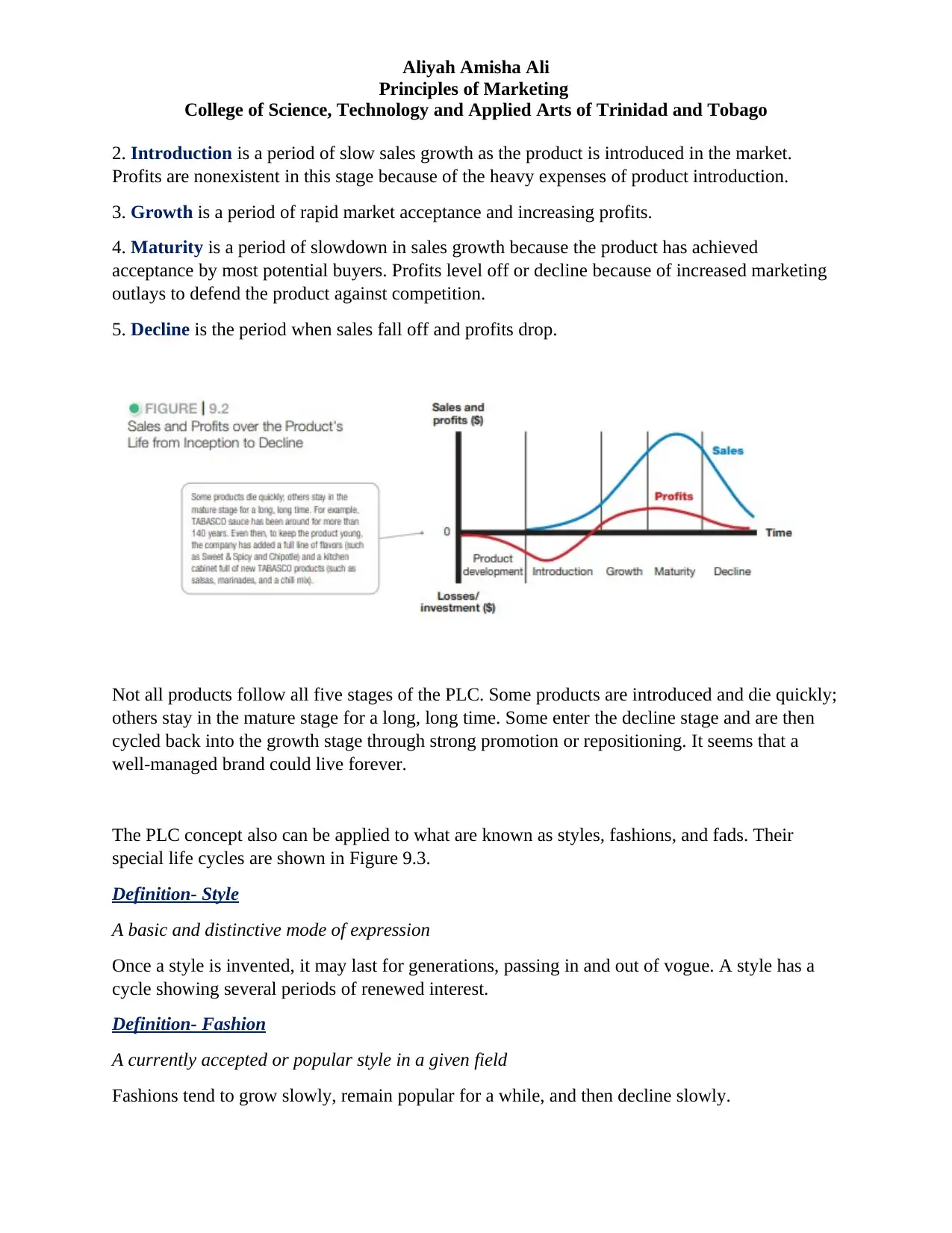
Aliyah Amisha Ali
Principles of Marketing
College of Science, Technology and Applied Arts of Trinidad and Tobago
2. Introduction is a period of slow sales growth as the product is introduced in the market.
Profits are nonexistent in this stage because of the heavy expenses of product introduction.
3. Growth is a period of rapid market acceptance and increasing profits.
4. Maturity is a period of slowdown in sales growth because the product has achieved
acceptance by most potential buyers. Profits level off or decline because of increased marketing
outlays to defend the product against competition.
5. Decline is the period when sales fall off and profits drop.
Not all products follow all five stages of the PLC. Some products are introduced and die quickly;
others stay in the mature stage for a long, long time. Some enter the decline stage and are then
cycled back into the growth stage through strong promotion or repositioning. It seems that a
well-managed brand could live forever.
The PLC concept also can be applied to what are known as styles, fashions, and fads. Their
special life cycles are shown in Figure 9.3.
Definition- Style
A basic and distinctive mode of expression
Once a style is invented, it may last for generations, passing in and out of vogue. A style has a
cycle showing several periods of renewed interest.
Definition- Fashion
A currently accepted or popular style in a given field
Fashions tend to grow slowly, remain popular for a while, and then decline slowly.
Principles of Marketing
College of Science, Technology and Applied Arts of Trinidad and Tobago
2. Introduction is a period of slow sales growth as the product is introduced in the market.
Profits are nonexistent in this stage because of the heavy expenses of product introduction.
3. Growth is a period of rapid market acceptance and increasing profits.
4. Maturity is a period of slowdown in sales growth because the product has achieved
acceptance by most potential buyers. Profits level off or decline because of increased marketing
outlays to defend the product against competition.
5. Decline is the period when sales fall off and profits drop.
Not all products follow all five stages of the PLC. Some products are introduced and die quickly;
others stay in the mature stage for a long, long time. Some enter the decline stage and are then
cycled back into the growth stage through strong promotion or repositioning. It seems that a
well-managed brand could live forever.
The PLC concept also can be applied to what are known as styles, fashions, and fads. Their
special life cycles are shown in Figure 9.3.
Definition- Style
A basic and distinctive mode of expression
Once a style is invented, it may last for generations, passing in and out of vogue. A style has a
cycle showing several periods of renewed interest.
Definition- Fashion
A currently accepted or popular style in a given field
Fashions tend to grow slowly, remain popular for a while, and then decline slowly.
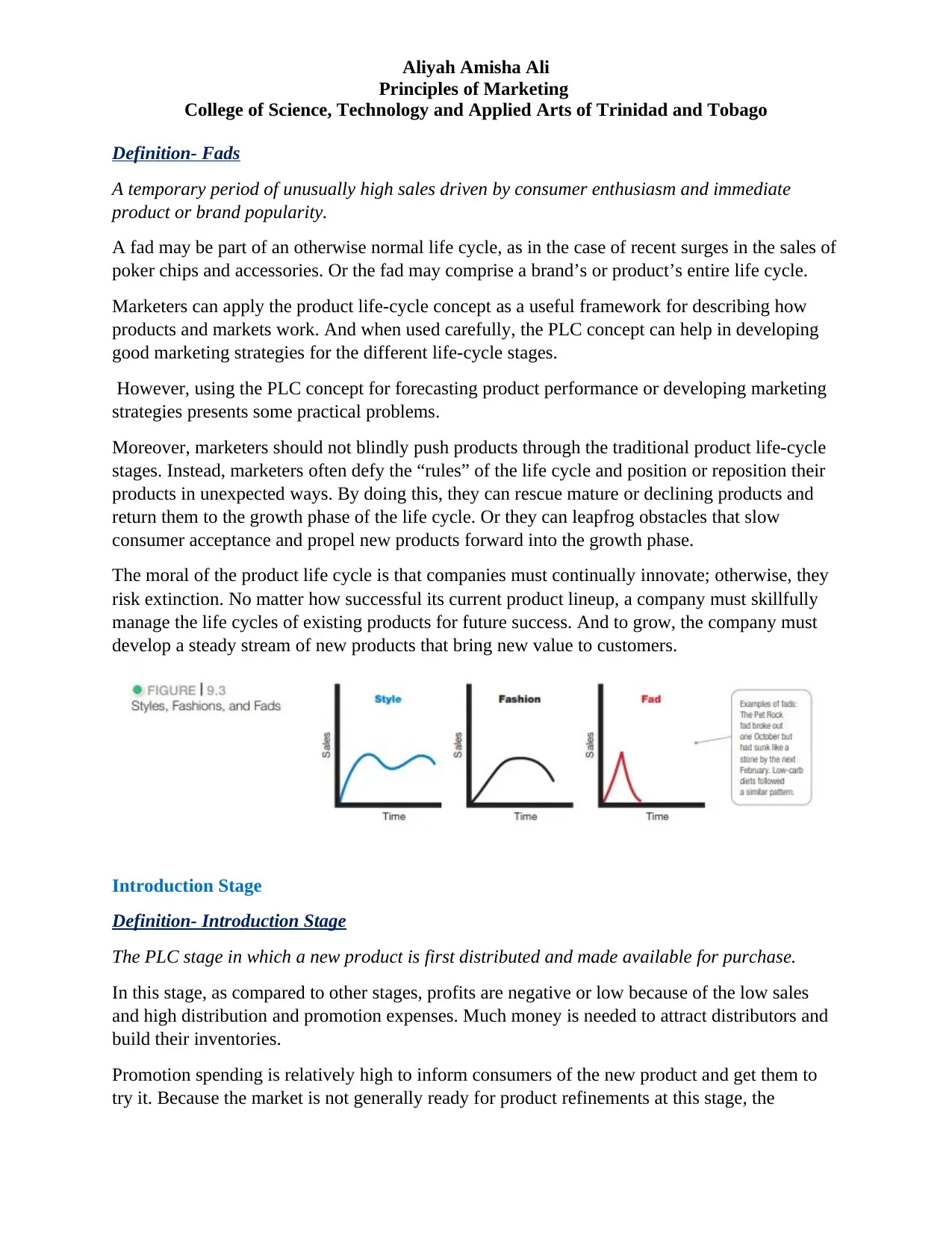
Aliyah Amisha Ali
Principles of Marketing
College of Science, Technology and Applied Arts of Trinidad and Tobago
Definition- Fads
A temporary period of unusually high sales driven by consumer enthusiasm and immediate
product or brand popularity.
A fad may be part of an otherwise normal life cycle, as in the case of recent surges in the sales of
poker chips and accessories. Or the fad may comprise a brand’s or product’s entire life cycle.
Marketers can apply the product life-cycle concept as a useful framework for describing how
products and markets work. And when used carefully, the PLC concept can help in developing
good marketing strategies for the different life-cycle stages.
However, using the PLC concept for forecasting product performance or developing marketing
strategies presents some practical problems.
Moreover, marketers should not blindly push products through the traditional product life-cycle
stages. Instead, marketers often defy the “rules” of the life cycle and position or reposition their
products in unexpected ways. By doing this, they can rescue mature or declining products and
return them to the growth phase of the life cycle. Or they can leapfrog obstacles that slow
consumer acceptance and propel new products forward into the growth phase.
The moral of the product life cycle is that companies must continually innovate; otherwise, they
risk extinction. No matter how successful its current product lineup, a company must skillfully
manage the life cycles of existing products for future success. And to grow, the company must
develop a steady stream of new products that bring new value to customers.
Introduction Stage
Definition- Introduction Stage
The PLC stage in which a new product is first distributed and made available for purchase.
In this stage, as compared to other stages, profits are negative or low because of the low sales
and high distribution and promotion expenses. Much money is needed to attract distributors and
build their inventories.
Promotion spending is relatively high to inform consumers of the new product and get them to
try it. Because the market is not generally ready for product refinements at this stage, the
Principles of Marketing
College of Science, Technology and Applied Arts of Trinidad and Tobago
Definition- Fads
A temporary period of unusually high sales driven by consumer enthusiasm and immediate
product or brand popularity.
A fad may be part of an otherwise normal life cycle, as in the case of recent surges in the sales of
poker chips and accessories. Or the fad may comprise a brand’s or product’s entire life cycle.
Marketers can apply the product life-cycle concept as a useful framework for describing how
products and markets work. And when used carefully, the PLC concept can help in developing
good marketing strategies for the different life-cycle stages.
However, using the PLC concept for forecasting product performance or developing marketing
strategies presents some practical problems.
Moreover, marketers should not blindly push products through the traditional product life-cycle
stages. Instead, marketers often defy the “rules” of the life cycle and position or reposition their
products in unexpected ways. By doing this, they can rescue mature or declining products and
return them to the growth phase of the life cycle. Or they can leapfrog obstacles that slow
consumer acceptance and propel new products forward into the growth phase.
The moral of the product life cycle is that companies must continually innovate; otherwise, they
risk extinction. No matter how successful its current product lineup, a company must skillfully
manage the life cycles of existing products for future success. And to grow, the company must
develop a steady stream of new products that bring new value to customers.
Introduction Stage
Definition- Introduction Stage
The PLC stage in which a new product is first distributed and made available for purchase.
In this stage, as compared to other stages, profits are negative or low because of the low sales
and high distribution and promotion expenses. Much money is needed to attract distributors and
build their inventories.
Promotion spending is relatively high to inform consumers of the new product and get them to
try it. Because the market is not generally ready for product refinements at this stage, the
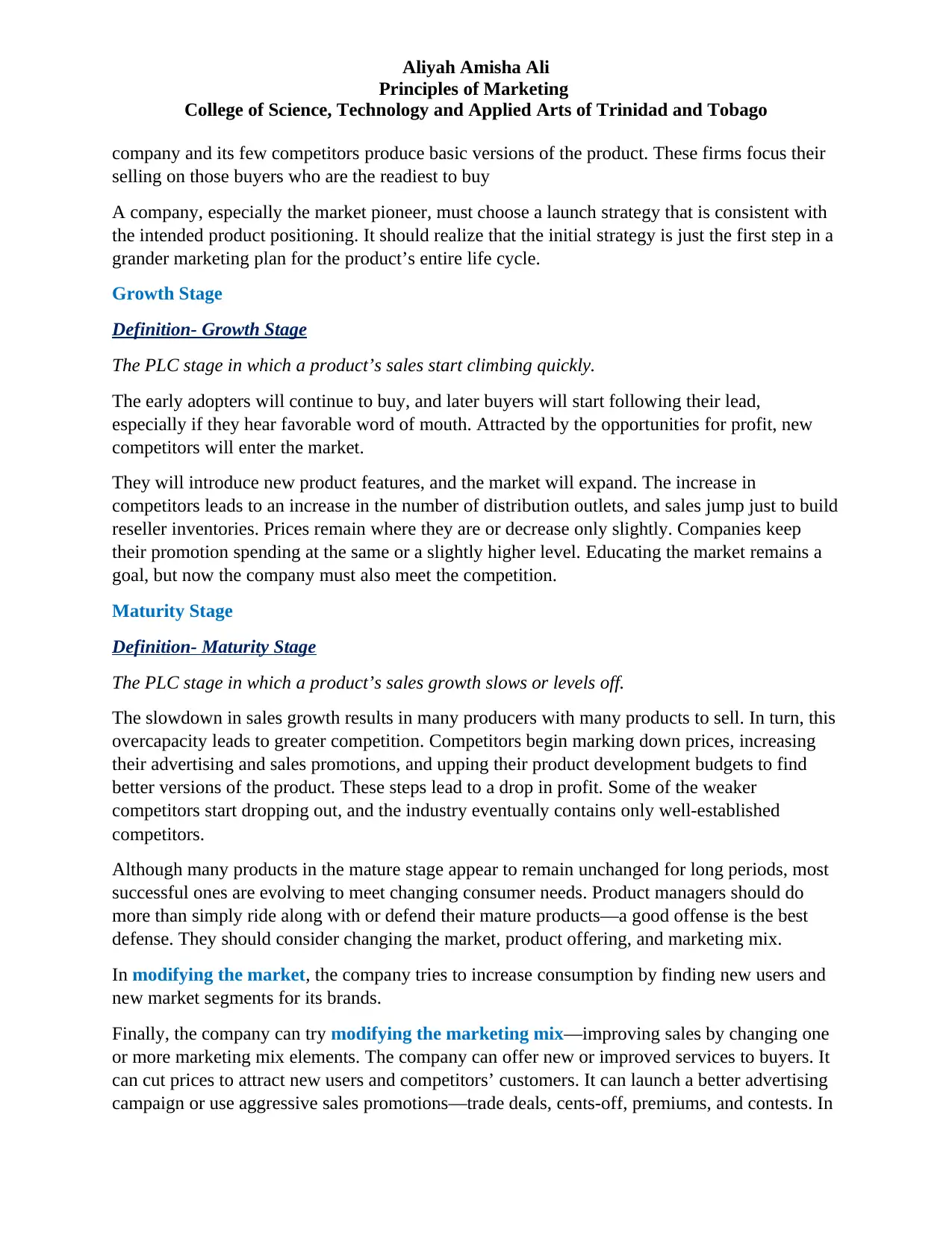
Aliyah Amisha Ali
Principles of Marketing
College of Science, Technology and Applied Arts of Trinidad and Tobago
company and its few competitors produce basic versions of the product. These firms focus their
selling on those buyers who are the readiest to buy
A company, especially the market pioneer, must choose a launch strategy that is consistent with
the intended product positioning. It should realize that the initial strategy is just the first step in a
grander marketing plan for the product’s entire life cycle.
Growth Stage
Definition- Growth Stage
The PLC stage in which a product’s sales start climbing quickly.
The early adopters will continue to buy, and later buyers will start following their lead,
especially if they hear favorable word of mouth. Attracted by the opportunities for profit, new
competitors will enter the market.
They will introduce new product features, and the market will expand. The increase in
competitors leads to an increase in the number of distribution outlets, and sales jump just to build
reseller inventories. Prices remain where they are or decrease only slightly. Companies keep
their promotion spending at the same or a slightly higher level. Educating the market remains a
goal, but now the company must also meet the competition.
Maturity Stage
Definition- Maturity Stage
The PLC stage in which a product’s sales growth slows or levels off.
The slowdown in sales growth results in many producers with many products to sell. In turn, this
overcapacity leads to greater competition. Competitors begin marking down prices, increasing
their advertising and sales promotions, and upping their product development budgets to find
better versions of the product. These steps lead to a drop in profit. Some of the weaker
competitors start dropping out, and the industry eventually contains only well-established
competitors.
Although many products in the mature stage appear to remain unchanged for long periods, most
successful ones are evolving to meet changing consumer needs. Product managers should do
more than simply ride along with or defend their mature products—a good offense is the best
defense. They should consider changing the market, product offering, and marketing mix.
In modifying the market, the company tries to increase consumption by finding new users and
new market segments for its brands.
Finally, the company can try modifying the marketing mix—improving sales by changing one
or more marketing mix elements. The company can offer new or improved services to buyers. It
can cut prices to attract new users and competitors’ customers. It can launch a better advertising
campaign or use aggressive sales promotions—trade deals, cents-off, premiums, and contests. In
Principles of Marketing
College of Science, Technology and Applied Arts of Trinidad and Tobago
company and its few competitors produce basic versions of the product. These firms focus their
selling on those buyers who are the readiest to buy
A company, especially the market pioneer, must choose a launch strategy that is consistent with
the intended product positioning. It should realize that the initial strategy is just the first step in a
grander marketing plan for the product’s entire life cycle.
Growth Stage
Definition- Growth Stage
The PLC stage in which a product’s sales start climbing quickly.
The early adopters will continue to buy, and later buyers will start following their lead,
especially if they hear favorable word of mouth. Attracted by the opportunities for profit, new
competitors will enter the market.
They will introduce new product features, and the market will expand. The increase in
competitors leads to an increase in the number of distribution outlets, and sales jump just to build
reseller inventories. Prices remain where they are or decrease only slightly. Companies keep
their promotion spending at the same or a slightly higher level. Educating the market remains a
goal, but now the company must also meet the competition.
Maturity Stage
Definition- Maturity Stage
The PLC stage in which a product’s sales growth slows or levels off.
The slowdown in sales growth results in many producers with many products to sell. In turn, this
overcapacity leads to greater competition. Competitors begin marking down prices, increasing
their advertising and sales promotions, and upping their product development budgets to find
better versions of the product. These steps lead to a drop in profit. Some of the weaker
competitors start dropping out, and the industry eventually contains only well-established
competitors.
Although many products in the mature stage appear to remain unchanged for long periods, most
successful ones are evolving to meet changing consumer needs. Product managers should do
more than simply ride along with or defend their mature products—a good offense is the best
defense. They should consider changing the market, product offering, and marketing mix.
In modifying the market, the company tries to increase consumption by finding new users and
new market segments for its brands.
Finally, the company can try modifying the marketing mix—improving sales by changing one
or more marketing mix elements. The company can offer new or improved services to buyers. It
can cut prices to attract new users and competitors’ customers. It can launch a better advertising
campaign or use aggressive sales promotions—trade deals, cents-off, premiums, and contests. In
Secure Best Marks with AI Grader
Need help grading? Try our AI Grader for instant feedback on your assignments.
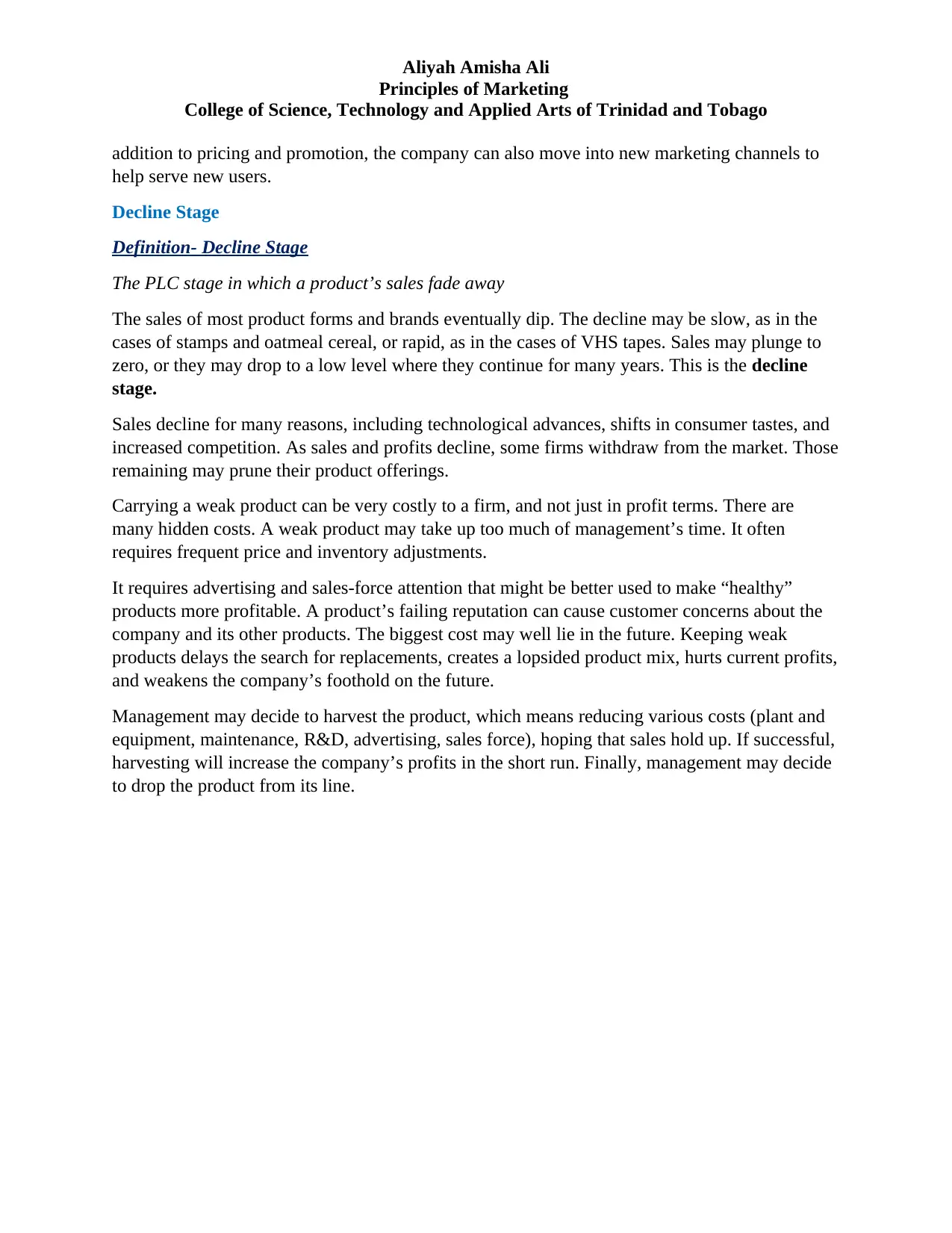
Aliyah Amisha Ali
Principles of Marketing
College of Science, Technology and Applied Arts of Trinidad and Tobago
addition to pricing and promotion, the company can also move into new marketing channels to
help serve new users.
Decline Stage
Definition- Decline Stage
The PLC stage in which a product’s sales fade away
The sales of most product forms and brands eventually dip. The decline may be slow, as in the
cases of stamps and oatmeal cereal, or rapid, as in the cases of VHS tapes. Sales may plunge to
zero, or they may drop to a low level where they continue for many years. This is the decline
stage.
Sales decline for many reasons, including technological advances, shifts in consumer tastes, and
increased competition. As sales and profits decline, some firms withdraw from the market. Those
remaining may prune their product offerings.
Carrying a weak product can be very costly to a firm, and not just in profit terms. There are
many hidden costs. A weak product may take up too much of management’s time. It often
requires frequent price and inventory adjustments.
It requires advertising and sales-force attention that might be better used to make “healthy”
products more profitable. A product’s failing reputation can cause customer concerns about the
company and its other products. The biggest cost may well lie in the future. Keeping weak
products delays the search for replacements, creates a lopsided product mix, hurts current profits,
and weakens the company’s foothold on the future.
Management may decide to harvest the product, which means reducing various costs (plant and
equipment, maintenance, R&D, advertising, sales force), hoping that sales hold up. If successful,
harvesting will increase the company’s profits in the short run. Finally, management may decide
to drop the product from its line.
Principles of Marketing
College of Science, Technology and Applied Arts of Trinidad and Tobago
addition to pricing and promotion, the company can also move into new marketing channels to
help serve new users.
Decline Stage
Definition- Decline Stage
The PLC stage in which a product’s sales fade away
The sales of most product forms and brands eventually dip. The decline may be slow, as in the
cases of stamps and oatmeal cereal, or rapid, as in the cases of VHS tapes. Sales may plunge to
zero, or they may drop to a low level where they continue for many years. This is the decline
stage.
Sales decline for many reasons, including technological advances, shifts in consumer tastes, and
increased competition. As sales and profits decline, some firms withdraw from the market. Those
remaining may prune their product offerings.
Carrying a weak product can be very costly to a firm, and not just in profit terms. There are
many hidden costs. A weak product may take up too much of management’s time. It often
requires frequent price and inventory adjustments.
It requires advertising and sales-force attention that might be better used to make “healthy”
products more profitable. A product’s failing reputation can cause customer concerns about the
company and its other products. The biggest cost may well lie in the future. Keeping weak
products delays the search for replacements, creates a lopsided product mix, hurts current profits,
and weakens the company’s foothold on the future.
Management may decide to harvest the product, which means reducing various costs (plant and
equipment, maintenance, R&D, advertising, sales force), hoping that sales hold up. If successful,
harvesting will increase the company’s profits in the short run. Finally, management may decide
to drop the product from its line.
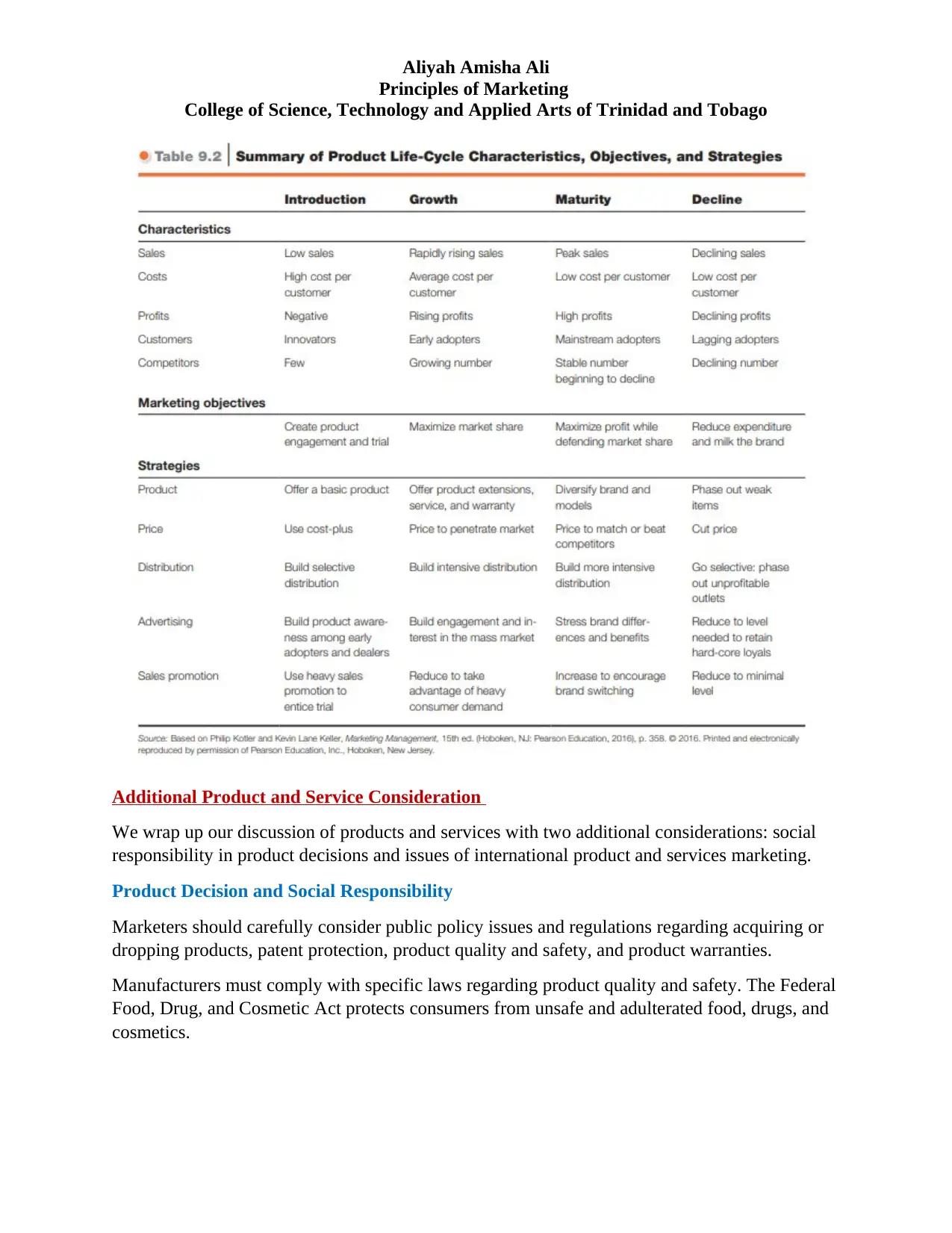
Aliyah Amisha Ali
Principles of Marketing
College of Science, Technology and Applied Arts of Trinidad and Tobago
Additional Product and Service Consideration
We wrap up our discussion of products and services with two additional considerations: social
responsibility in product decisions and issues of international product and services marketing.
Product Decision and Social Responsibility
Marketers should carefully consider public policy issues and regulations regarding acquiring or
dropping products, patent protection, product quality and safety, and product warranties.
Manufacturers must comply with specific laws regarding product quality and safety. The Federal
Food, Drug, and Cosmetic Act protects consumers from unsafe and adulterated food, drugs, and
cosmetics.
Principles of Marketing
College of Science, Technology and Applied Arts of Trinidad and Tobago
Additional Product and Service Consideration
We wrap up our discussion of products and services with two additional considerations: social
responsibility in product decisions and issues of international product and services marketing.
Product Decision and Social Responsibility
Marketers should carefully consider public policy issues and regulations regarding acquiring or
dropping products, patent protection, product quality and safety, and product warranties.
Manufacturers must comply with specific laws regarding product quality and safety. The Federal
Food, Drug, and Cosmetic Act protects consumers from unsafe and adulterated food, drugs, and
cosmetics.
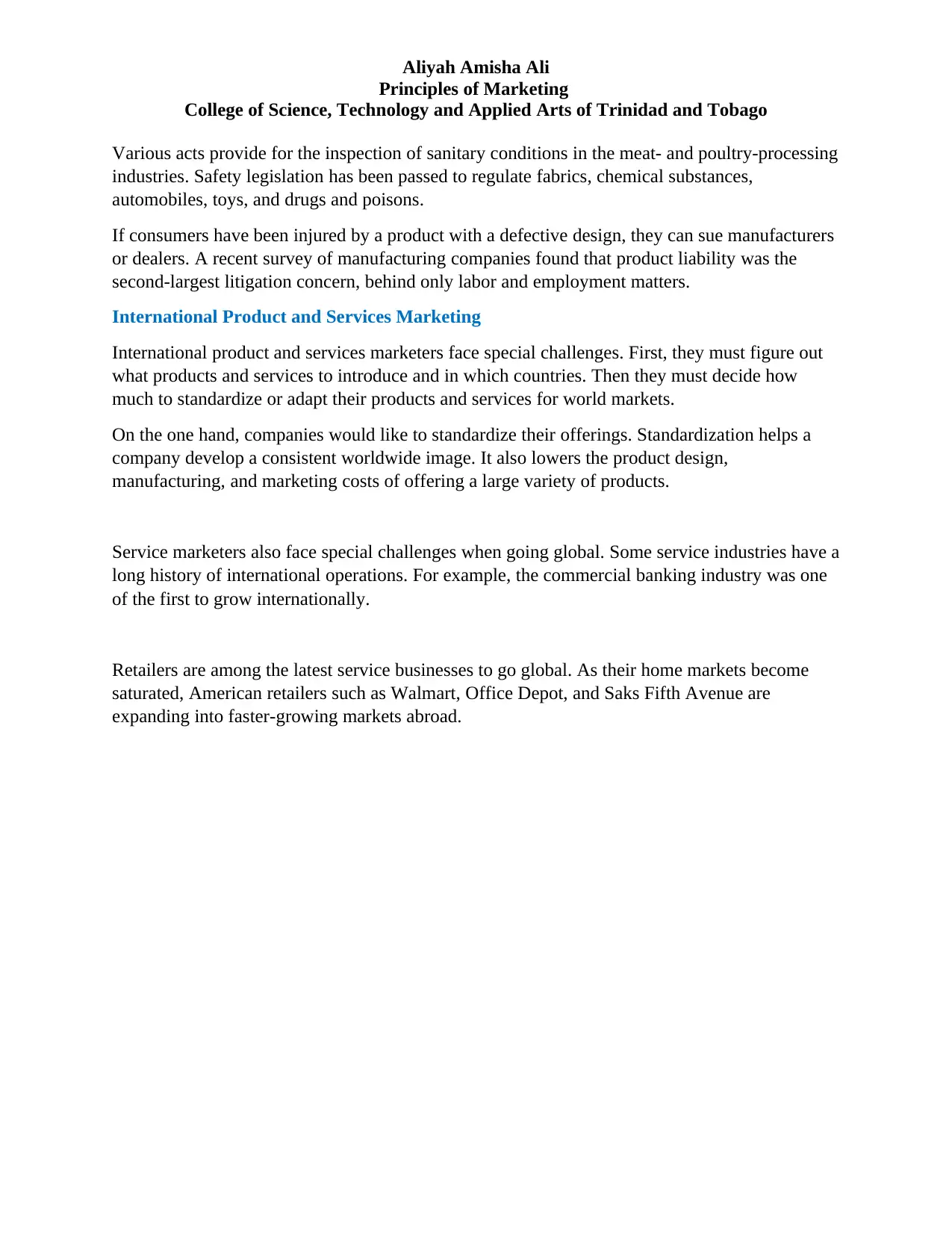
Aliyah Amisha Ali
Principles of Marketing
College of Science, Technology and Applied Arts of Trinidad and Tobago
Various acts provide for the inspection of sanitary conditions in the meat- and poultry-processing
industries. Safety legislation has been passed to regulate fabrics, chemical substances,
automobiles, toys, and drugs and poisons.
If consumers have been injured by a product with a defective design, they can sue manufacturers
or dealers. A recent survey of manufacturing companies found that product liability was the
second-largest litigation concern, behind only labor and employment matters.
International Product and Services Marketing
International product and services marketers face special challenges. First, they must figure out
what products and services to introduce and in which countries. Then they must decide how
much to standardize or adapt their products and services for world markets.
On the one hand, companies would like to standardize their offerings. Standardization helps a
company develop a consistent worldwide image. It also lowers the product design,
manufacturing, and marketing costs of offering a large variety of products.
Service marketers also face special challenges when going global. Some service industries have a
long history of international operations. For example, the commercial banking industry was one
of the first to grow internationally.
Retailers are among the latest service businesses to go global. As their home markets become
saturated, American retailers such as Walmart, Office Depot, and Saks Fifth Avenue are
expanding into faster-growing markets abroad.
Principles of Marketing
College of Science, Technology and Applied Arts of Trinidad and Tobago
Various acts provide for the inspection of sanitary conditions in the meat- and poultry-processing
industries. Safety legislation has been passed to regulate fabrics, chemical substances,
automobiles, toys, and drugs and poisons.
If consumers have been injured by a product with a defective design, they can sue manufacturers
or dealers. A recent survey of manufacturing companies found that product liability was the
second-largest litigation concern, behind only labor and employment matters.
International Product and Services Marketing
International product and services marketers face special challenges. First, they must figure out
what products and services to introduce and in which countries. Then they must decide how
much to standardize or adapt their products and services for world markets.
On the one hand, companies would like to standardize their offerings. Standardization helps a
company develop a consistent worldwide image. It also lowers the product design,
manufacturing, and marketing costs of offering a large variety of products.
Service marketers also face special challenges when going global. Some service industries have a
long history of international operations. For example, the commercial banking industry was one
of the first to grow internationally.
Retailers are among the latest service businesses to go global. As their home markets become
saturated, American retailers such as Walmart, Office Depot, and Saks Fifth Avenue are
expanding into faster-growing markets abroad.
1 out of 13
Related Documents
Your All-in-One AI-Powered Toolkit for Academic Success.
+13062052269
info@desklib.com
Available 24*7 on WhatsApp / Email
![[object Object]](/_next/static/media/star-bottom.7253800d.svg)
Unlock your academic potential
© 2024 | Zucol Services PVT LTD | All rights reserved.





